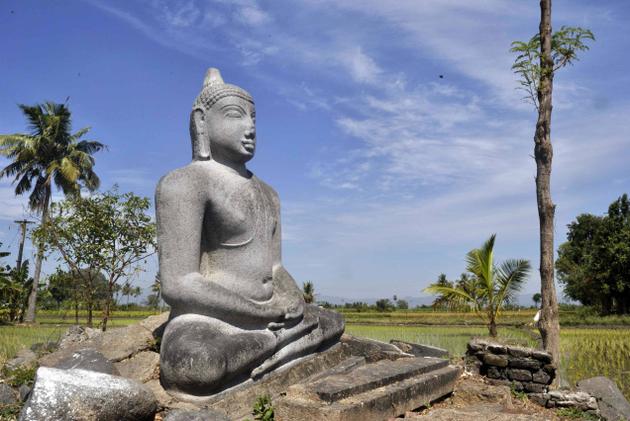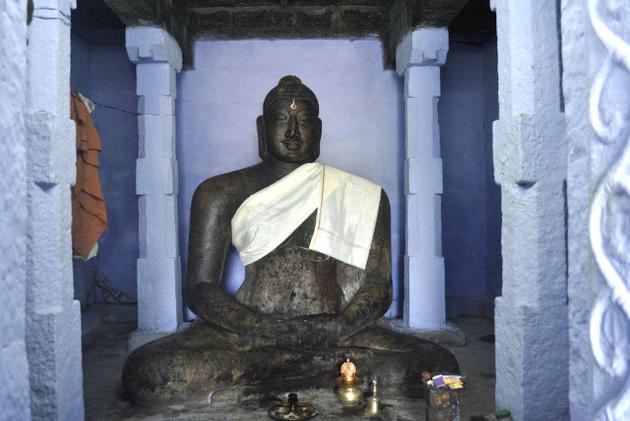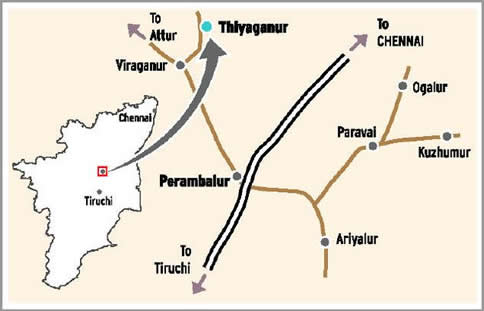Ilankai Tamil Sangam30th Year on the Web Association of Tamils of Sri Lanka in the USA |
||||||
 Home Home Archives Archives |
Buddha at the Crossroadsby A. Srivasthan, The Hindu, Chennai, June 9, 2012
What explains the large number of Buddha statues in and around Thiyaganur, a nondescript Tamil Nadu village? We may never know, says A. SRIVATHSAN, after taking in some unusual forms of the Shakya Muni. In most ways, Thiyaganur is a typical village in Tamil Nadu. Matchbox houses with gleaming white walls and red earth tiles, fields with irregular patterns, a provision store that sells garishly coloured beverages, and the occasional bus chugging through. The lime-washed temple, in this village 80 km north-west of Tiruchi, has a familiar air about it too. Until one gets closer.
Inside this modest structure, framed by four granite columns, is a six-foot Buddha — cross-legged, contemplative and smiling. The hitherto unnoticed peepal tree on the roadside, shading the temple, suddenly draws venerable attention. This is not the only Buddha that the villages of Thiyagnur are familiar with. Around them, in their fields, on their roads and in the many villages nearby, lie scattered centuries-old Buddha sculptures — seated calmly and smiling benignly. How did they come here? The dense presence of Buddhas in this far-flung region is intriguing. Though Buddhism was widespread in Tamil Nadu, this region is not among the well-known Buddhist centres. The sculptures are a puzzle, and probably hold the key to an important part of history that is yet to be written. The Buddha, as the Buddhist texts describe, is strikingly handsome, serene and radiant as “a palm-tree fruit just loosened from the stalk”. His calm appearance, topped with coal-black hair, is profoundly impressive. Villagers in Thiyaganur have not read these texts nor do they know about Buddhism, but they still vouch that these Buddha idols are kindly, attractive and bestow the boons one wishes for.
This is not surprising. To these villagers, He is not Shakya Muni — as the rest of the world knows the Buddha — but one of their Hindu gods. They fondly wrap Him with a silk angavasthram (an upper garment worn by the Tamil upper class), apply a streak of sandal paste on his forehead, and make offerings of coconut, plantain and camphor. They often beseech Him with prayers for good luck, well being and quick cure for their ailments. They call Him Buddha Sami (Buddha god). G. Pandurangan, 71, the retired livestock supervisor now in charge of the temple, says, “People from a Buddhist monastery near Bangalore visited this temple sometime back. They wanted us to go to Bangalore and undertake training in the proper way to conduct rituals. They promised to bear the expenses. But we were not interested. He is our Buddha Sami and we want to worship him in the manner we know. We take good care of this temple and offer him sakarai pongal (sweetened steamed rice) and sundal (steamed and fried chick pea).” Buddhism reached Tamil country during Emperor Ashoka's reign — Third Century BCE. Its emphasis on moral values and egalitarian ideals were widely embraced. For 700 years, Buddhism flourished and coexisted peacefully with Jainism, Ajivikas and various sects of Hinduism. During the Sixth Century CE, the Bhakti movement and its Tamil saints seriously challenged Buddhism; royal patronage shifted and Buddhism's influence became limited. When Hsuan Tsang, the Chinese traveller, visited South India in the Seventh Century, it was well past its prime. A long presence But contrary to popular perception, Buddhism did not completely disappear after this period. The discovery of many 13th Century Buddhist bronzes in Nagapattinam, the presence of Virasoliyam (an 11th Century grammar text composed by a Buddhist), and references to eminent scholars such as Anuruddha and Dharmakirti in later Buddhist texts establish that the religion thrived at least until the 14th Century. Nor was Buddhism limited to big urban centres like Kanchipuram or Madurai. The sculptures of Thiyaganur offer ample proof. These statues — described more appropriately as Perambalur Buddhas, after the nearest well-known town — are stylistically datable to approximately the 11th Century. They are the last of the few in-situ evidences that speak of the wide presence of Buddhism. Protecting them is critical for any attempt to restore and rewrite a balanced history of South India. But they are perilously close to being lost. Apart from half-a-dozen Buddha stone sculptures found in villages around Thiyaganur — and worshipped by villagers — the others have been either decapitated or are close to destruction. One such headless Buddha can be found amidst wildly grown thorns and vines in the backyard of a house in Kuzhumoor village. “Though not worshipped, He was at least intact when I last saw him,” lamented M. Selvapandiyan, a research scholar interested in the history of the Pachamalai tribal belt, hills that border Perambalur, who spotted this sculpture about six years ago. The photographs in his collection showed a serene Buddha with a profound smile. The villagers suspect two strangers who were roaming the streets a few months ago. “The two must have cut the head and taken it away. Perhaps they were idol thieves,” a few villagers living nearby speculated. However, none filed a complaint. Not enough Of the two Buddhas in Thiyaganur, the villagers worship one and ignore the other — a stunning, broad-shouldered Buddha, framed by a lone thin tree and seated under a canopy of blue sky — located in private property, amidst fields. The property owners continue to farm around the statue, without damaging it, but that may not be enough to safeguard it. The base of the sculpture is dangerously inclined, and it holds on to the earth precariously. A relatively small-sized Buddha, overlooking a four-way junction in the nearby village of Paravai, fares somewhat better, as He is firmly cemented to a platform. But barring a few locals who garland Him before leaving abroad to work, this Buddha is barely attended to. He has no canopy or cover over the head. This is not the case with the Buddha in a Dalit colony in Veeraganur. Lakshmi and her husband Muthuswami, a retired schoolteacher, regularly clean the statue, sweep the street in front and apply sacred ash on the forehead and arms of the statue. There are no elaborate pujas or rituals, but often, in the silent night, people come to place a stone on the idol's head. To them, it is an offering that will help get rid of headache and related body pain. Among all the Buddhas in the Perambalur region, the one in Ogalur is very popular, particularly with the `Friends in Dubai,' a loose group of locals who work in West Asia. Members of this group pooled their money and raised Buddha from the sidewalks of the street to a higher platform. On the eve of their departure, they climb the flight of steps to garland him without fail. They believe that this old practice brings luck and protects them. These appropriations have not disfigured the icons nor have they forced a name change. The villagers address and know these sculptures as Buddha — the curled hair, the tuft, the long ears and robes are still identifiable. But this is poor consolation. The question is whether these historical treasures survive to see the future. Art alone is not at stake; historical geography is too. Nagapattinam Buddhas Apart from stone sculptures, more than 400 Buddhist bronzes have been unearthed in Tamil Nadu. More than 350 are from the ancient port of Nagapattinam. This historic city was an active Buddhist centre during the Chola period. During the 11th century CE, the Sailendra kings of Sumatra built a large vihara here, which was visited by Buddhist monks from different countries. A 15th century Pali inscription discovered at the old city of Pegu in Burma attests to this. Ruins of a ‘Buddhist pagoda', till the Jesuit missionaries demolished them in the 19th century, were visible in Nagapattinam. The Theravada or orthodox form of Buddhism, which views the Buddha as a great ascetic rather than a god, was widely prevalent in Tamil Nadu. However, many of the Nagapattinam bronzes belong to the the opposing tradition – the Mahayana, which views the Buddha as a superhuman. Along with the Buddha, images of Boddhisatvas such as Avalokitesvara were also discovered. These images, like the other Chola bronzes, are of appreciable artistic merit. Many of these bronzes are now part of the Chennai Government Museum collection. Unfortunately, only a small number is currently on display. For further reading: The Nagapattinam and other Buddhist Bronzes in the Madras Government Museum, T.N. Ramachandran, Museum Publication, 1954. |
|||||
|
||||||


